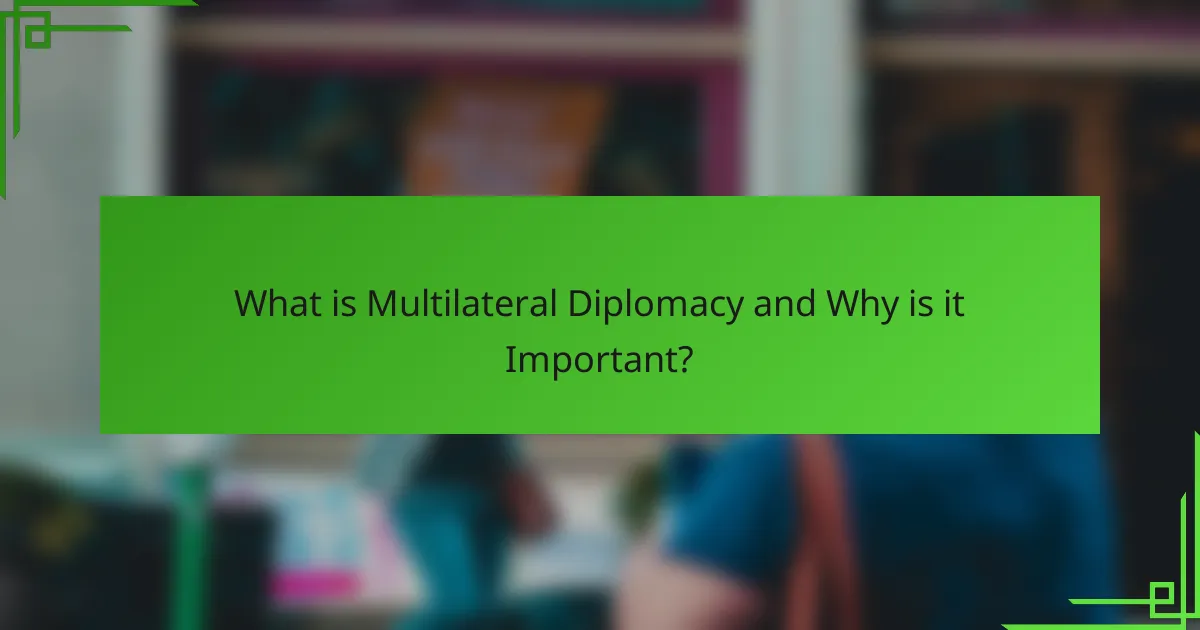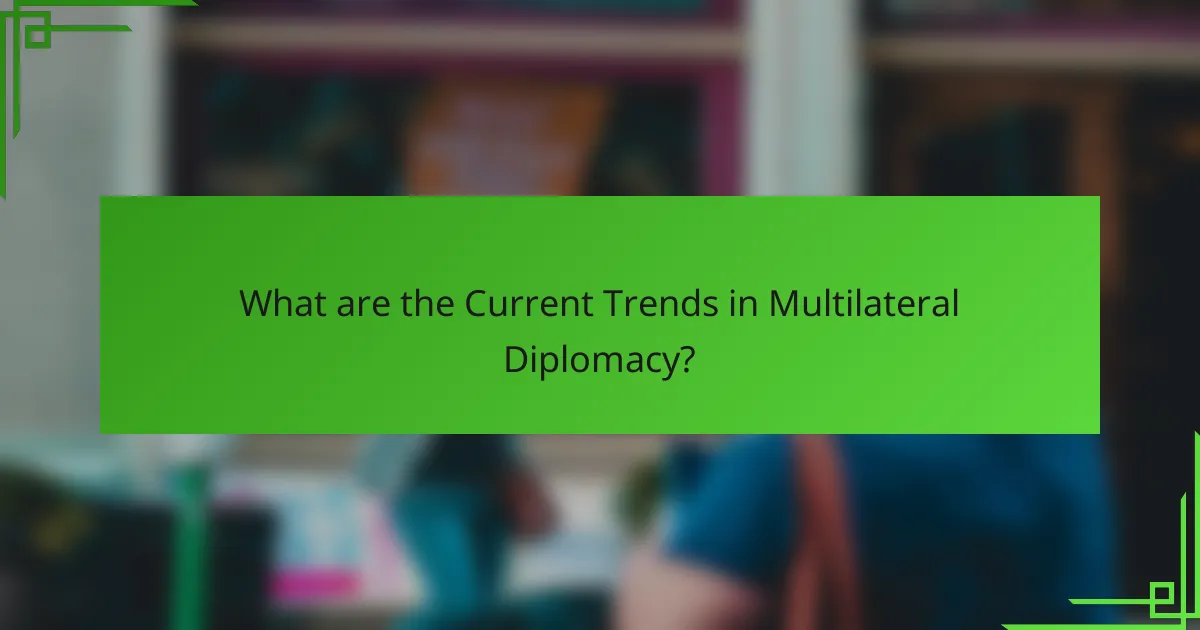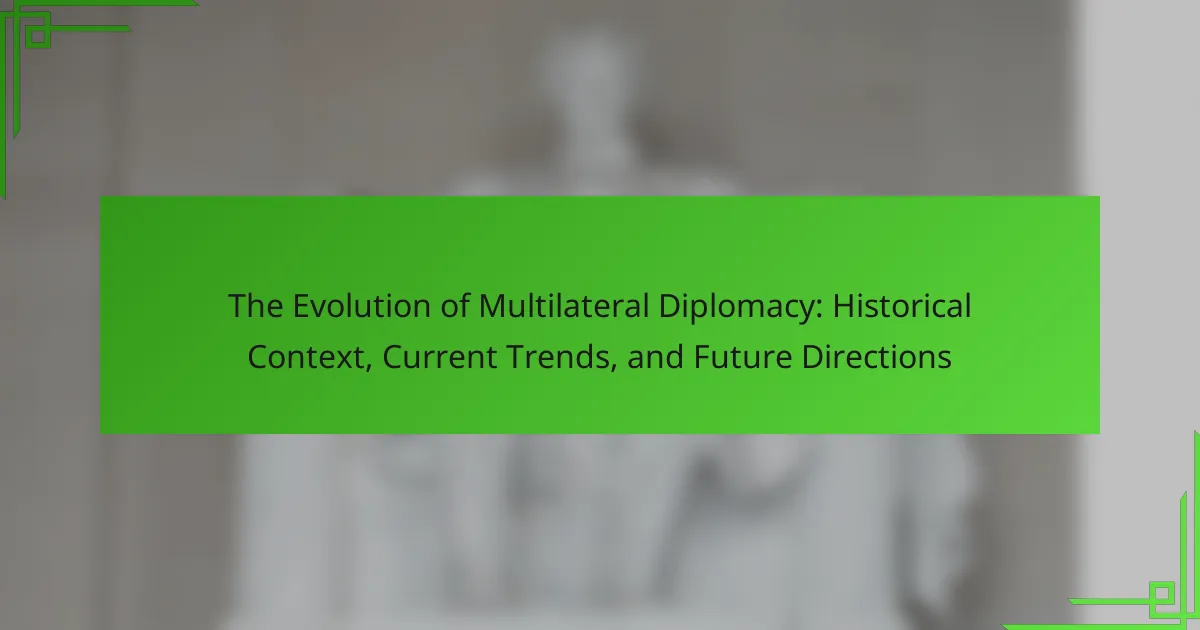Multilateral diplomacy is the process in which multiple countries engage in dialogue and negotiation to tackle global challenges. This approach is crucial for fostering international cooperation and collective decision-making on issues such as climate change, security threats, and trade disputes. The article explores the historical context of multilateral diplomacy, current trends emphasizing climate action, global health, and technology governance, as well as future directions for enhanced collaboration among nations. It highlights the role of organizations like the United Nations and regional bodies, and the growing influence of non-state actors in shaping diplomatic discussions. Overall, the article provides a comprehensive overview of how multilateral diplomacy is evolving to address complex global issues through collective action.

What is Multilateral Diplomacy and Why is it Important?
Multilateral diplomacy is the process where multiple countries engage in dialogue and negotiation to address global issues. It is important because it fosters international cooperation and collective decision-making. Multilateral diplomacy allows nations to address challenges like climate change, security threats, and trade disputes collaboratively. For example, the United Nations serves as a platform for multilateral diplomacy, bringing together 193 member states to discuss and resolve global issues. This approach enhances legitimacy and inclusivity in international relations. Additionally, multilateral agreements can lead to more comprehensive solutions than bilateral negotiations. Historical instances, such as the Paris Agreement on climate change, showcase the effectiveness of multilateral diplomacy in achieving common goals.
How has Multilateral Diplomacy evolved over time?
Multilateral diplomacy has evolved significantly since its inception. Initially, it was characterized by bilateral agreements between nations. The 19th century saw the formation of international organizations, such as the Concert of Europe, which aimed to maintain peace among major powers. Following World War I, the League of Nations was established, marking a formal commitment to multilateralism. The United Nations was created after World War II, solidifying multilateral diplomacy as a cornerstone of international relations.
In recent decades, multilateral diplomacy has expanded to include various global issues, such as climate change and trade. The rise of regional organizations, like the European Union and ASEAN, has further diversified diplomatic efforts. Digital communication has also transformed how states engage in multilateral discussions. Today, multilateral diplomacy is essential for addressing complex global challenges, fostering cooperation among a wider range of actors, including non-state entities.
What historical events have shaped Multilateral Diplomacy?
The Treaty of Westphalia in 1648 marked the beginning of modern multilateral diplomacy. It ended the Thirty Years’ War and established principles of state sovereignty and non-interference. The Congress of Vienna in 1815 further shaped multilateral diplomacy by creating a framework for European cooperation. This congress aimed to maintain peace after the Napoleonic Wars through collective decision-making. The League of Nations, established after World War I in 1920, aimed to prevent future conflicts through multilateral dialogue. However, its failure to stop World War II highlighted weaknesses in multilateral approaches. The formation of the United Nations in 1945 represented a significant evolution in multilateral diplomacy. It provided a platform for international cooperation on a global scale. The Cold War era introduced new challenges and dynamics, emphasizing the importance of multilateralism in addressing global issues. Major summits, such as the G7 and G20, have since emerged to tackle economic and political challenges collaboratively.
How did the establishment of international organizations influence Multilateral Diplomacy?
The establishment of international organizations significantly enhanced multilateral diplomacy. These organizations provided structured platforms for dialogue among nations. They facilitated cooperation on global issues, such as security, trade, and human rights. The United Nations, established in 1945, exemplifies this influence by promoting collective decision-making. Organizations like NATO and the World Trade Organization also shaped diplomatic relations. They created formal rules and norms for international interactions. This structure reduced conflicts and fostered peaceful resolutions. Additionally, they enabled smaller nations to participate in global discussions, amplifying their voices. Overall, international organizations transformed multilateral diplomacy into a more inclusive and systematic process.
What are the core principles of Multilateral Diplomacy?
The core principles of multilateral diplomacy include cooperation, consensus-building, and inclusivity. Cooperation is essential for addressing global challenges that require collective action. Consensus-building fosters agreement among diverse nations, ensuring that all voices are heard. Inclusivity involves engaging all relevant stakeholders in the diplomatic process. These principles are reflected in organizations like the United Nations, which emphasizes collaboration among member states. Historical examples, such as the establishment of the League of Nations, illustrate the importance of these principles in promoting peace and stability.
How do cooperation and negotiation play a role in Multilateral Diplomacy?
Cooperation and negotiation are essential components of multilateral diplomacy. They enable countries to address shared challenges through collective action. Multilateral diplomacy often involves multiple stakeholders with diverse interests. Cooperation helps build consensus among these stakeholders. Negotiation facilitates dialogue and compromise to reach agreements. Historical examples, such as the Paris Agreement, highlight the importance of these processes. The agreement was achieved through extensive negotiations among 196 parties. This illustrates how cooperation and negotiation can lead to successful outcomes in global governance.
What is the significance of consensus-building in Multilateral Diplomacy?
Consensus-building in multilateral diplomacy is crucial for achieving collective agreements among diverse nations. It fosters cooperation and mutual understanding among parties with differing interests. Effective consensus-building enhances the legitimacy of agreements, making them more likely to be upheld. Historical examples, such as the Paris Agreement, demonstrate how consensus enables broad participation and commitment. Furthermore, consensus-building can prevent conflicts and promote stability in international relations. The process encourages dialogue and negotiation, which are essential for addressing global challenges collaboratively. Therefore, consensus-building is a foundational element in the success of multilateral diplomacy.
What challenges does Multilateral Diplomacy face today?
Multilateral diplomacy faces significant challenges today, including geopolitical tensions and power imbalances. Increasingly, nations prioritize bilateral agreements over collective action. The rise of populism also undermines multilateral cooperation. Additionally, global issues like climate change require unified responses that are often difficult to achieve. The COVID-19 pandemic has further strained international collaboration. Trust deficits among nations complicate negotiations and consensus-building. Furthermore, the proliferation of non-state actors disrupts traditional diplomatic channels. These factors collectively hinder the effectiveness of multilateral diplomacy in addressing global issues.
How do geopolitical tensions impact Multilateral Diplomacy?
Geopolitical tensions significantly disrupt multilateral diplomacy. They create divisions among nations, often leading to a breakdown in communication. Countries may prioritize bilateral relations over multilateral engagements. This shift can diminish the effectiveness of international organizations like the UN. For example, during the Cold War, geopolitical tensions hindered collective decision-making. Nations often aligned with opposing blocs, which stifled consensus-building efforts. Additionally, rising nationalism can complicate multilateral negotiations. Countries may resist compromises that threaten their sovereignty. Overall, geopolitical tensions challenge the collaborative spirit essential for successful multilateral diplomacy.
What role do non-state actors play in contemporary Multilateral Diplomacy?
Non-state actors play a significant role in contemporary multilateral diplomacy. These entities include non-governmental organizations (NGOs), multinational corporations, and civil society groups. They contribute to shaping international policies and norms. Non-state actors often provide expertise and resources that states may lack. Their engagement can enhance dialogue and foster collaboration among nations. For example, NGOs have been pivotal in addressing climate change through advocacy and policy influence. Additionally, multinational corporations can drive economic partnerships that influence diplomatic relations. Their participation in forums like the United Nations highlights their impact on global governance. Overall, non-state actors are essential in bridging gaps between governments and society in the diplomatic landscape.
How is technology influencing Multilateral Diplomacy?
Technology is significantly influencing multilateral diplomacy by enhancing communication and collaboration among nations. Digital platforms enable real-time discussions and negotiations, reducing the time needed for decision-making. Video conferencing tools allow for virtual summits, making diplomacy more accessible and cost-effective. Data analytics provides insights into global issues, guiding diplomatic strategies. Social media amplifies public engagement and awareness of international relations. Cybersecurity concerns have also led to new diplomatic dialogues focused on protecting national interests. The rise of artificial intelligence is transforming how states analyze and respond to diplomatic challenges. Overall, technology is reshaping the landscape of multilateral diplomacy, making it more dynamic and responsive to global changes.
What are the benefits and drawbacks of digital diplomacy?
Digital diplomacy offers several benefits and drawbacks. Benefits include enhanced communication efficiency. Digital platforms allow for rapid information dissemination. They also enable broader outreach to global audiences. Additionally, digital tools facilitate real-time engagement and feedback. This can lead to more informed decision-making.
However, drawbacks exist. Digital diplomacy can lead to misinformation spread. The lack of control over online narratives can undermine credibility. Cybersecurity threats pose risks to sensitive diplomatic communications. Furthermore, reliance on technology may diminish personal relationships. This can hinder trust-building among nations.
How can technology enhance communication between nations?
Technology enhances communication between nations by enabling instant information exchange. Digital platforms facilitate real-time dialogue between governments, organizations, and citizens. Video conferencing tools allow for face-to-face discussions without geographical barriers. Social media enables rapid dissemination of information and public engagement. Data analytics improves understanding of global issues through insights derived from large datasets. Online collaboration tools streamline diplomatic negotiations and joint initiatives. According to the United Nations, technology has transformed diplomatic practices, making them more transparent and accessible. These advancements foster stronger international relations and mutual understanding.

What are the Current Trends in Multilateral Diplomacy?
Current trends in multilateral diplomacy include increasing emphasis on climate change, global health, and technology governance. Nations are prioritizing collaborative efforts to address climate issues, exemplified by the Paris Agreement. The COVID-19 pandemic has highlighted the need for global health cooperation, leading to initiatives like COVAX for equitable vaccine distribution. Additionally, technology governance is becoming crucial as countries navigate cybersecurity and data privacy challenges. The rise of regional organizations also reflects a trend towards localized multilateralism. Furthermore, non-state actors are gaining influence in diplomatic discussions, impacting policy-making processes. These trends indicate a shift towards more inclusive and adaptive diplomatic frameworks.
How are global issues shaping current Multilateral Diplomatic efforts?
Global issues significantly shape current multilateral diplomatic efforts. Issues such as climate change, pandemics, and international security compel nations to collaborate. The Paris Agreement exemplifies global climate diplomacy, uniting countries to combat climate change. The COVID-19 pandemic highlighted the necessity for coordinated health responses. Vaccine distribution required multilateral agreements to ensure equitable access. Additionally, geopolitical tensions drive nations to seek diplomatic solutions through forums like the United Nations. These global challenges necessitate a collective approach, reinforcing the importance of multilateralism in addressing shared concerns.
What is the impact of climate change on Multilateral Diplomacy?
Climate change significantly impacts multilateral diplomacy by altering global priorities and increasing international cooperation. Nations face urgent climate-related challenges that require collaborative solutions. This shift has led to frameworks like the Paris Agreement, which emphasizes collective action. Countries now engage in negotiations focused on emissions reductions and climate adaptation strategies. The urgency of climate issues has also influenced funding and resource allocation in diplomatic discussions. Additionally, climate change has heightened tensions between developed and developing nations regarding responsibilities and capabilities. As a result, multilateral forums increasingly prioritize climate resilience in their agendas.
How does public health influence international relations today?
Public health significantly influences international relations today through collaborative efforts in disease prevention and health security. Countries increasingly recognize that health issues transcend borders. Global pandemics, such as COVID-19, have highlighted the interconnectedness of nations. The World Health Organization (WHO) plays a crucial role in coordinating international health responses. Countries often engage in diplomacy to secure medical supplies and vaccines. Health diplomacy can strengthen alliances and foster cooperation. For example, the COVAX initiative exemplifies global collaboration for equitable vaccine distribution. Additionally, public health data sharing enhances transparency and trust among nations. Overall, public health is a key factor in shaping diplomatic relations in the contemporary global landscape.
What role do emerging powers play in Multilateral Diplomacy?
Emerging powers play a significant role in multilateral diplomacy by influencing global governance structures. They contribute to shaping international norms and policies through participation in organizations like the G20 and BRICS. Their growing economic strength allows them to advocate for issues relevant to developing nations. For instance, Brazil, India, and South Africa have pushed for reforms in the United Nations Security Council. This advocacy reflects their desire for a more equitable global order. Emerging powers also enhance the diversity of perspectives in diplomatic discussions. Their involvement often leads to more comprehensive solutions to global challenges. For example, they have been instrumental in negotiations on climate change and sustainable development.
How has the rise of BRICS nations affected traditional power dynamics?
The rise of BRICS nations has significantly altered traditional power dynamics in global politics. BRICS, comprising Brazil, Russia, India, China, and South Africa, represents emerging economies challenging Western dominance. These nations have increased their economic influence, contributing to a shift from a unipolar world led by the U.S. to a multipolar landscape. For instance, BRICS countries collectively account for over 40% of the world’s population and about 25% of global GDP. This economic weight enhances their bargaining power in international forums. Additionally, the establishment of the New Development Bank by BRICS offers alternatives to Western-led financial institutions. This shift encourages developing nations to seek partnerships beyond traditional Western alliances. The rise of BRICS also reflects a growing demand for a more equitable global governance structure, as these nations advocate for reforms in institutions like the United Nations and the International Monetary Fund.
What influence do regional organizations have on global diplomacy?
Regional organizations significantly influence global diplomacy by facilitating cooperation among member states. They provide platforms for dialogue and negotiation. For example, the European Union has established common policies that impact international relations. The African Union promotes peace and security initiatives across the continent. Regional organizations often address specific regional issues that may not be prioritized on a global scale. Their collective actions can lead to more effective responses to crises. Additionally, they often serve as intermediaries in conflicts, enhancing diplomatic engagement. By fostering regional stability, these organizations contribute to a more balanced global diplomatic landscape.
How are multilateral agreements being negotiated in the current landscape?
Multilateral agreements are currently being negotiated through a combination of formal summits and informal dialogues. Countries engage in discussions to address global challenges such as climate change, trade, and security. These negotiations often involve multiple stakeholders, including governments, NGOs, and private sectors. The use of digital platforms has increased, allowing for broader participation and faster communication. Collaborative frameworks are emphasized to build consensus among diverse nations. Recent examples include the Paris Agreement and trade negotiations under the World Trade Organization. These agreements reflect a shift towards inclusive and transparent processes. The evolving geopolitical landscape influences the urgency and focus of these negotiations.
What strategies are used to facilitate negotiations among diverse nations?
Negotiation strategies among diverse nations include diplomacy, cultural sensitivity, and consensus-building. Diplomacy fosters dialogue and understanding between nations. Cultural sensitivity involves recognizing and respecting different cultural norms and values. Consensus-building aims to find common ground among conflicting interests. These strategies enhance communication and reduce misunderstandings. Historical examples include the United Nations’ peacekeeping efforts and trade agreements. Such strategies have proven effective in resolving conflicts and promoting cooperation.
How do cultural differences impact the negotiation process?
Cultural differences significantly impact the negotiation process. They influence communication styles, decision-making approaches, and relationship-building strategies. For instance, in some cultures, direct communication is valued, while in others, indirect communication is preferred. This can lead to misunderstandings during negotiations. Additionally, cultures may prioritize collective decision-making over individual input, affecting how agreements are reached. Research by Hofstede shows that cultural dimensions, such as individualism versus collectivism, can shape negotiation tactics. Understanding these differences is crucial for successful outcomes in international diplomacy.

What are the Future Directions of Multilateral Diplomacy?
The future directions of multilateral diplomacy include enhanced cooperation on global challenges. These challenges encompass climate change, health pandemics, and international security. Countries are increasingly recognizing the need for collaborative solutions. The rise of regional organizations reflects this trend. For instance, the European Union and ASEAN are strengthening diplomatic ties. Technological advancements are also shaping multilateral interactions. Digital diplomacy is becoming more prevalent, facilitating communication and negotiations. Furthermore, non-state actors are gaining influence in multilateral forums. Their participation can lead to more inclusive decision-making processes. Overall, multilateral diplomacy is evolving to address complex global issues through collective action.
What predictions can be made about the future of Multilateral Diplomacy?
The future of multilateral diplomacy is likely to be shaped by increasing global interdependence and emerging geopolitical challenges. Nations will prioritize collaboration to address issues such as climate change, health pandemics, and security threats. The rise of non-state actors will also influence diplomatic efforts. These actors include international organizations, NGOs, and corporations that play significant roles in global governance. Additionally, digital diplomacy will become more prevalent as technology facilitates communication and negotiation.
According to the United Nations, multilateral cooperation is essential for achieving the Sustainable Development Goals by 2030. This underscores the importance of collective action in addressing global challenges. Furthermore, the shifting balance of power, particularly with the rise of China, will necessitate new frameworks for multilateral engagement. Historical precedents indicate that successful diplomacy often hinges on adaptability and inclusivity.
In summary, the future of multilateral diplomacy will likely involve enhanced cooperation, the influence of diverse stakeholders, and the integration of technology.
How might global governance evolve in the coming decades?
Global governance may evolve through increased collaboration among nations and adaptation to emerging global challenges. Countries are likely to prioritize multilateralism to address issues like climate change and pandemics. The rise of non-state actors may also influence decision-making processes. Technological advancements could enhance transparency and participation in governance structures. Additionally, regional governance frameworks may gain prominence in addressing localized issues. Historical precedents, such as the establishment of the United Nations, indicate a trend towards collective action. The ongoing shifts in power dynamics, particularly with the rise of emerging economies, will further shape governance models. These factors suggest a more interconnected and responsive global governance landscape in the coming decades.
What potential new frameworks could emerge for international cooperation?
Potential new frameworks for international cooperation may include digital diplomacy platforms. These platforms can facilitate real-time communication among nations. They can enhance transparency and accountability in international agreements. Another framework could be regional cooperation coalitions. These coalitions focus on specific geographic areas to address localized issues. Collaborative climate action agreements may also emerge. Such agreements would unite countries to combat climate change collectively. Additionally, public-private partnerships could become a framework for addressing global challenges. These partnerships leverage resources and expertise from both sectors. Lastly, multilateral treaties on emerging technologies could be developed. These treaties would govern the use and impact of technologies like artificial intelligence.
How can nations prepare for future challenges in Multilateral Diplomacy?
Nations can prepare for future challenges in multilateral diplomacy by enhancing their diplomatic capacities and fostering collaboration. This involves investing in training for diplomats to navigate complex international issues. Nations should also prioritize building strong alliances with other countries to address global challenges collectively. Engaging in multilateral forums, such as the United Nations, can help nations stay informed about emerging issues.
Furthermore, adopting technology in diplomacy can improve communication and data sharing among nations. Participating in joint exercises and simulations can prepare diplomats for real-world scenarios. Countries must also focus on understanding cultural differences to facilitate better negotiations. By proactively addressing these aspects, nations can strengthen their ability to respond to future diplomatic challenges effectively.
What skills will diplomats need to navigate future complexities?
Diplomats will need strong analytical skills to navigate future complexities. These skills allow them to assess global issues effectively. Communication skills will be equally important. Clear communication fosters better understanding among diverse stakeholders. Cultural competence is vital for engaging with various nations. This skill helps diplomats respect and understand different perspectives. Negotiation skills will be essential for resolving conflicts. Effective negotiation can lead to successful agreements. Adaptability is crucial in the face of rapid changes. Diplomats must adjust strategies based on evolving geopolitical landscapes. Technological proficiency will also be necessary. Understanding digital tools enhances diplomatic engagement and information sharing. Lastly, emotional intelligence will help diplomats manage relationships. This skill aids in building trust and rapport with counterparts.
How can collaboration among nations be strengthened moving forward?
Collaboration among nations can be strengthened through enhanced diplomatic dialogue and cooperative frameworks. Establishing regular communication channels fosters trust and understanding. Joint initiatives on global challenges, such as climate change and health crises, create shared goals. Multilateral agreements and treaties formalize commitments and responsibilities. Engaging in cultural exchanges promotes mutual respect and awareness. Utilizing technology for virtual summits increases participation and accessibility. Investment in international organizations reinforces collaborative efforts. Historical examples, like the Paris Agreement, illustrate effective multilateral cooperation. These strategies collectively enhance the ability of nations to work together for common interests.
What best practices can enhance the effectiveness of Multilateral Diplomacy?
Effective multilateral diplomacy can be enhanced through several best practices. First, establishing clear communication channels among all parties is essential. This fosters transparency and builds trust. Second, prioritizing consensus-building is crucial for addressing diverse interests. It encourages collaboration and mutual understanding. Third, leveraging technology can streamline negotiations and facilitate real-time information sharing. This enhances engagement and responsiveness. Fourth, involving non-state actors enriches discussions. Their perspectives can lead to innovative solutions. Lastly, continuous evaluation of diplomatic strategies ensures adaptability to changing global dynamics. Historical examples show that these practices lead to more successful outcomes in multilateral negotiations.
How can transparency and accountability improve diplomatic relations?
Transparency and accountability can significantly enhance diplomatic relations by fostering trust among nations. When countries operate transparently, they share information openly, reducing misunderstandings. This openness encourages collaboration and joint problem-solving. Accountability ensures that states uphold their commitments, reinforcing reliability in international agreements. Historical examples, such as the Helsinki Accords, illustrate how transparency can lead to improved relations during the Cold War. Trust built through these practices can lead to more effective negotiations and conflict resolution. Ultimately, these principles create a foundation for stable and constructive diplomatic interactions.
What role does education and training play in successful Multilateral Diplomacy?
Education and training are crucial for successful multilateral diplomacy. They equip diplomats with essential skills and knowledge. Understanding international laws and protocols is fundamental. Training enhances negotiation techniques and conflict resolution strategies. Education fosters cultural awareness and sensitivity, which are vital in diverse settings. Historical examples show that well-trained diplomats achieve better outcomes. For instance, the Dayton Accords were facilitated by skilled negotiators. Comprehensive education programs improve analytical thinking and strategic planning. These competencies lead to more effective collaboration among nations.
The primary entity of this article is multilateral diplomacy, which refers to the process of multiple countries engaging in dialogue and negotiation to address global issues. The article examines the historical evolution of multilateral diplomacy, highlighting key events and organizations that have shaped its development. It discusses current trends, such as the influence of non-state actors and technology, as well as the challenges faced today, including geopolitical tensions and public health crises. Furthermore, the article explores future directions for multilateral diplomacy, emphasizing the importance of cooperation and the adaptation of diplomatic strategies to effectively address complex global challenges.
